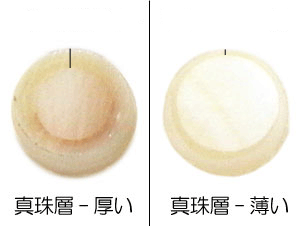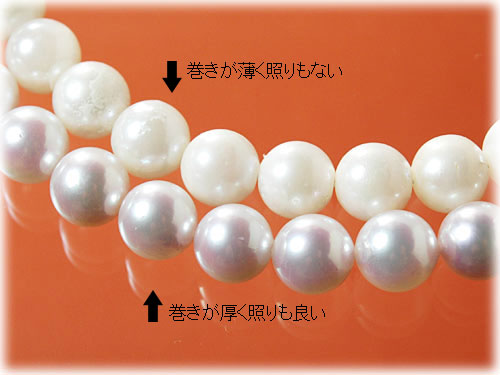Standards for Evaluating Pearl Quality
The six main standards used to evaluate pearl quality are: nacre thickness, luster, shape, size, color, and the presence of blemishes. As a general rule, the overall balance is more important than any single attribute, and it may be helpful to keep this in mind as you read on.
The thickness of a pearl's nacre is a vital factor in determining its quality. A nacre which is too thin results in a lack of the natural beauty which rightfully belongs to the pearl. The term "nacre" refers to the layers of mother-of-pearl surrounding the nucleus which is the core of the pearl. If this layering is too thin, the core of the pearl will be visible through the gem's surface. Unfortunately, it is not rare to see such inferior specimens on the market.
No matter how large a pearl is, and regardless of nacre thickness, an unsatisfactory luster will lower a pearl's value. A good rule of thumb is that, if the luster is good, your reflection will be visible in the pearl's surface. The clearer the reflection is, the higher the quality of the luster.
Left: Thick Nacre
Right: Thin Nacre
Up: Thin Nacre
Down: Thick Nacre
By contrast, - though this applies for "thick nacre pearls" - the thicker the nacre, the duller the luster. Sometimes "look like thick" is more important than actual thickness. Pearl professionals always examine with a balance between nacre thickness and luster.
For Akoya cultured pearls, the four main pearl shapes are "round","semi-round", "semi-baroque", and "baroque". When evaluating a pearl's shape, perfectly spherical gems are, of course, desirable; however, this does not mean that other shapes are undesirable. Baroque pearls and oval-shaped semi-round pearls are certainly attractive, and have long been used to accent casual attire.
When discussing pearl size, perhaps the first thing that comes to mind is "the bigger, the better". Large pearls are, naturally, more valuable, provided that there is harmony among the other important criteria. Only rarely are unusually large pearls found among the Akoya pearls cultivated in Japan today, however; the average size of a pearl with nicely-balanced attributes is between 8-10mm.
Here in Japan, pink is the color of choice, and pink pearls are generally priced higher. Following in popularity are the white and silver varieties. However, we feel that pearls should not be confined to use only with formal attire. As well as making a nice addition to any collection, golden, green, and blue pearls lend an air of simple elegance to casual wear.
Strictly speaking, it is quite rare to find a pearl free of blemishes, as the oysters which produce the pearls are living creatures. A pearl's blemishes are therefore judged by how easily they can be detected, and of course, the fewer, the better. Usually, a pearl is deemed satisfactory if there are no detectable blemishes from a distance of approximately 1 foot (30cm). As always, though, it is best to think in terms of total balance, rather than emphasize any single criterion.
The above criteria are the key to selecting pearls of good quality. There are, however, a few other things to be aware of. Pearls give the most natural glow under the morning sunlight. Spotlights also enhance their appearance. Therefore, if, when shopping for pearls, the items are being displayed under direct sunlight or bright artificial light, it would be best to request to have them removed before examining them. Furthermore, when red objects are present around pearls, reddish reflection automatically gives the appearance of a thick nacre. To be safe, it is advisable to shop in the morning, before the afternoon sky begins to change color, and to avoid wearing red or similar-colored clothing. Please feel free to contact us anytime with questions regarding pearl selection.


 E-Mail
E-Mail



 http://www.yokota-pearl.co.jp/
http://www.yokota-pearl.co.jp/